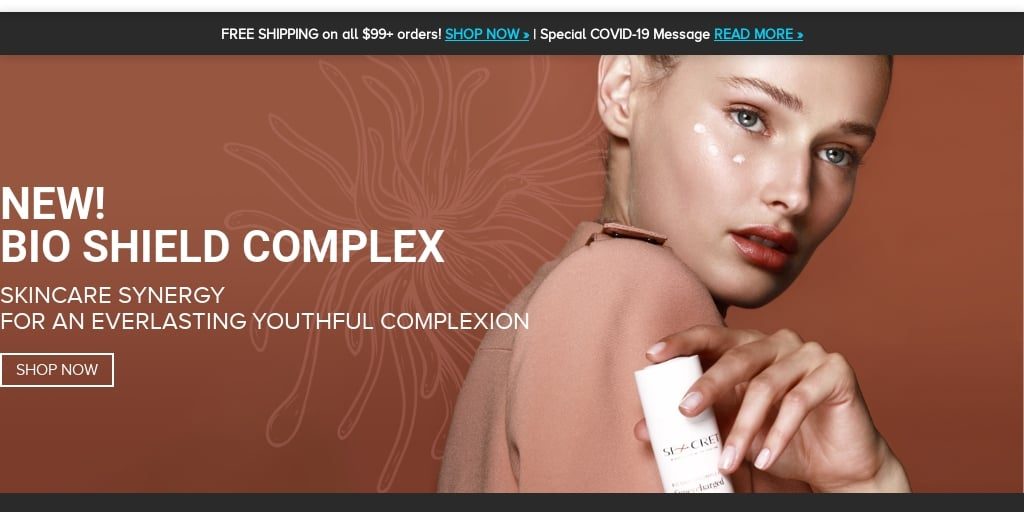 In the digital age, a skincare brand’s website is often the first point of contact for potential customers. A well-designed, high-performing website can significantly impact your brand’s visibility, customer engagement, and, most importantly, sales. Creating a skincare website that produces results involves more than just attractive design. It requires strategic planning, customer-centric content, and user-friendly functionality. Find out here how to create skincare websites that produce results. Product sales, customer acquisition, and more from skin care industry experts. Need help? Work with skin care business consultants or get started with skin care marketing services.
In the digital age, a skincare brand’s website is often the first point of contact for potential customers. A well-designed, high-performing website can significantly impact your brand’s visibility, customer engagement, and, most importantly, sales. Creating a skincare website that produces results involves more than just attractive design. It requires strategic planning, customer-centric content, and user-friendly functionality. Find out here how to create skincare websites that produce results. Product sales, customer acquisition, and more from skin care industry experts. Need help? Work with skin care business consultants or get started with skin care marketing services.
In this guide, we will walk you through essential steps to create a skincare website that delivers real results.
Design a User-Friendly Experience
A skincare website must be visually appealing, but functionality is even more crucial. If your website is difficult to navigate or slow to load, potential customers may leave before they even explore your products. This is a key component of how to create skincare websites that produce results.
Here’s how to ensure a user-friendly experience:
- Mobile Optimization: More than 50% of global website traffic now comes from mobile devices. This means your skincare website must be fully optimized for mobile viewing. A responsive design ensures your website looks and functions perfectly on all screen sizes, offering a seamless user experience.
- Simple Navigation: Skincare shoppers need to find what they’re looking for quickly. Keep your navigation simple by organizing your products into categories such as cleansers, moisturizers, anti-aging, or sensitive skin solutions. Use a clear and intuitive menu that makes it easy to explore the site.
- Fast Load Times: Slow websites frustrate users and can increase bounce rates. Optimize images, enable browser caching, and minimize code to ensure fast load times. A website that loads in under three seconds is optimal for keeping customers engaged.
- Easy Checkout Process: Cart abandonment is a common issue for online skincare retailers. Simplify your checkout process by minimizing the number of steps required to complete a purchase. Offering guest checkout, multiple payment options, and visible security features will boost customer trust and conversions.
With a well-structured, fast-loading, and easy-to-navigate website, you set the foundation for an exceptional user experience.
Create a Compelling Brand Story
In the beauty and skincare industry, brand storytelling plays a significant role in connecting with customers. Today’s consumers are more inclined to support brands that resonate with their values, offer authenticity, and create emotional connections.
When creating your skincare website, be sure to communicate your brand story clearly and compellingly. Consider the following:
- About Us Page: Share the journey of your brand—what inspired you to start a skincare line, what makes your products unique, and how your values align with the needs of your target audience. Personal stories or anecdotes can help make your brand more relatable.
- Highlight Ingredients and Benefits: Skincare customers care about what they’re putting on their skin. Provide clear, concise information about your product ingredients, their benefits, and how they improve skin health. Offering transparency will help build trust.
- Sustainability and Ethics: If your brand prioritizes sustainable, cruelty-free, or vegan products, make sure to showcase this on your website. Customers are increasingly looking for eco-friendly and ethically produced products, and highlighting these aspects can differentiate your brand.
Telling a strong brand story allows your audience to connect emotionally with your products and feel confident in their purchase decisions.
Optimize for SEO to Drive Organic Traffic
No matter how beautifully designed your website is, it won’t produce results unless people can find it. You want to know how to create skincare websites that produce results? Search engine optimization (SEO) ensures that your website appears in search results when potential customers look for skincare products.
Here are some key SEO strategies to implement:
- Keyword Research: Identify the keywords your target audience is searching for, such as “best natural skincare for acne” or “anti-aging serums.” Use tools like Google Keyword Planner or SEMrush to find high-volume, low-competition keywords relevant to your products.
- On-Page SEO: Optimize every page of your website by incorporating targeted keywords into titles, meta descriptions, headers, and product descriptions. Avoid keyword stuffing; instead, aim for natural placement that enhances the user experience.
- Product Descriptions: Write detailed, unique product descriptions that highlight the features, ingredients, and benefits of each product. Include relevant keywords, but focus on making the descriptions engaging and informative.
- Blog Content: A blog can boost your SEO efforts by providing valuable, keyword-rich content. Write blog posts about skincare routines, ingredient benefits, beauty tips, and skincare trends. High-quality content will drive organic traffic and establish your brand as an authority in the industry.
By optimizing your website for search engines, you can attract more organic traffic and improve your visibility to potential customers.
Leverage High-Quality Visuals and Videos
The skincare industry is highly visual. Customers want to see how your products look and, more importantly, how they can benefit their skin. High-quality images and videos can have a significant impact on the perceived value of your brand and products.
Here’s how to leverage visuals effectively:
- Product Photography: Invest in professional photography that highlights your skincare products in detail. Use close-ups to showcase textures, packaging, and ingredients. Create images that inspire trust and make customers want to try your products.
- Before-and-After Photos: Skincare customers are result-driven. Featuring before-and-after photos of real customers using your products can demonstrate effectiveness and encourage purchases. Ensure these images are authentic and show visible improvements.
- Tutorial Videos: Video content is one of the most engaging forms of media. Create skincare tutorial videos that demonstrate how to use your products properly or show skincare routines. Videos are an excellent way to explain complicated concepts in a simple and digestible way.
- 3D Product Visualization: Consider using 3D imaging tools to create a virtual experience where customers can interact with your products online. This technology enhances the customer experience and creates a memorable interaction with your brand.
Visual content increases engagement, builds trust, and helps customers make informed purchasing decisions.
Incorporate Social Proof and Reviews
In the beauty industry, social proof is a powerful tool to influence buying decisions. Potential customers are more likely to purchase skincare products when they see positive reviews, testimonials, and endorsements from others.
To leverage social proof effectively:
- Customer Reviews: Encourage customers to leave reviews after purchasing. Display these reviews on product pages and allow potential buyers to filter reviews by skin type or concerns. Genuine reviews build credibility and reduce skepticism about trying new products.
- Testimonials: Add testimonials from satisfied customers or influencers who have used your products. Featuring these prominently on your homepage or landing pages can instill confidence in potential buyers.
- User-Generated Content: Encourage your customers to share their experiences with your products on social media. Feature their photos or videos on your website as part of a “customer spotlight” section. Not only does this serve as social proof, but it also encourages community engagement.
Social proof validates the quality and effectiveness of your products, making it easier for customers to trust your brand and complete their purchases.
Implement Conversion Rate Optimization (CRO)
A well-designed skincare website isn’t just about driving traffic; it’s about converting visitors into customers. Conversion rate optimization (CRO) ensures that the people who visit your website are encouraged to take action, whether that’s making a purchase, signing up for a newsletter, or engaging with your brand.
Here’s how to optimize your website for conversions:
- Clear Calls to Action (CTAs): Every page should have a clear and compelling CTA, whether it’s “Buy Now,” “Shop the Collection,” or “Get a Free Sample.” Use strong, action-oriented language that motivates customers to take the next step.
- Exit-Intent Popups: Use exit-intent popups to capture potential customers before they leave your site. Offer a discount or free shipping to incentivize them to complete their purchase.
- Cart Abandonment Emails: Set up automated emails that are triggered when customers leave items in their cart without checking out. These reminders, paired with a discount or incentive, can bring customers back to complete their purchase.
- A/B Testing: Test different elements of your website, such as CTA placement, color schemes, or product descriptions, to see what resonates most with your audience. Continuous testing and optimization will lead to higher conversion rates.
Optimizing for conversions ensures that your website turns visitors into paying customers, maximizing your revenue.
Build Trust with Security and Transparency
When customers shop online, they need to feel confident that their personal and payment information is secure. For skincare websites, where customers may return for repeat purchases, trust is essential.
Here’s how to build trust:
- SSL Certificates: Ensure your website is SSL-certified (look for the padlock symbol in the browser bar). This encrypts data and protects your customers’ information during transactions.
- Visible Contact Information: Make sure your contact information is easy to find. Include a dedicated “Contact Us” page with email, phone number, and live chat options. This transparency makes customers feel comfortable reaching out if they have questions.
- Clear Return Policy: A transparent return and refund policy reduces the perceived risk of buying skincare products online. Make sure your return policy is clearly stated and easy to understand, allowing customers to shop with confidence.
When customers trust your brand and feel secure on your website, they’re more likely to make a purchase and become repeat buyers.
Conclusion
Creating a skincare website that produces results involves a strategic blend of user-friendly design, compelling storytelling, high-quality visuals, SEO, and conversion optimization. By focusing on the customer experience, leveraging social proof, and building trust through transparency and security, your website can become a powerful tool for driving sales and growing your skincare brand. With the right approach, your website can turn visitors into loyal customers and boost your business’s long-term success. That’s how to create skincare websites that produce results. Product sales, customer acquisition, and more from skin care industry experts. Need help? Work with skin care business consultants or get started with skin care marketing services.








